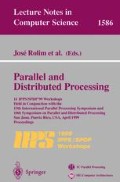Abstract
We propose a prediction-based best-effort real-time service to support distributed, interactive applications in shared, unreserved computing environments. These applications have timing requirements, but can continue to function when deadlines are missed. In addition, they expose two kinds of adaptability: tasks can be run on any host, and their resource demands can be adjusted based on user-perceived quality. After defining this class of applications, we describe a significant example, an earthquake visualization tool, and show how it could benefit from the service. Finally, we present evidence that the service is feasible in the form of two studies of algorithms for host load prediction and for predictive task mapping.
Preview
Unable to display preview. Download preview PDF.
References
Balakrishnan, H., Stemm, M., Seshan, S., and Katz, R. H. Analyzing stability in wide-area network performance. In Proceedings of SIGMETRICS’97 (1997), ACM, pp. 2–12.
Bao, H., Bielak, J., Ghattas, O., Kallivokas, L. F., O’Hallaron, D. R., Shewchuk, J. R., and Xu, J. Large-scale Simulation of Elastic Wave Propagation in Heterogeneous Media on Parallel Computer. Computer Methods in Applied Mechanics and Engineering 152, 1–2 (Jan. 1998), 85–102.
Basu, S., Mukherjee, A., and Klivansky, S. Time series models for internet traffic. Tech. Rep. GIT-CC-95-27, College of Computing, Georgia Institute of Technology, February 1995.
BBN Corporation. Distributed spatial technology laboratories: Openmap. (web page). http://javamap.bbn.com/.
Beran, J. Statistical methods for data with long-range dependence. Statistical Science 7, 4 (1992), 404–427.
Bestavros, A., and Spartiotis, D. Probabilistic job scheduling for distributed real-time applications. In Proceedings of the First IEEE Workshop on Real-Time Applications (May 1993).
Bolliger, J., Gross, T., and Hengartner, U. Bandwidth modelling for network-aware applications. In Proceedings of Infocomm’99 (1999). to appear.
Box, G. E. P., Jenkins, G. M., and Reinsel, G.Time Series Analysis: Forecasting and Control, 3rd ed. Prentice Hall, 1994.
Dinda, P. A. The statistical properties of host load. In Proc. of 4th Workshop on Languages, Compilers, and Run-time Systems for Scalable Computers (LCR’98) (Pittsburgh, PA, 1998), vol. 1511 of Lecture Notes in Computer Science, Springer-Verlag, pp. 319–334. Extended version available as CMU Technical Report CMU-CS-TR-98-143.
Dinda, P. A., Lowekamp, B., Kallivokas, L. F., and O’Hallaron, D. R. The case for prediction-based best-effort real-time systems. Tech. Rep. CMU-CS-TR-98-174, School of Computer science, Carnegie Mellon University, 1998.
Dinda, P. A., and O’Hallaron, D. R. An evaluation of linear models for host load prediction. Tech. Rep. CMU-CS-TR-98-148, School of Computer Science, Carnegie Mellon University, November 1998.
Embley, D. W., and Nagy, G. Behavioral aspects of text editors. ACM Computing Surveys 13, 1 (January 1981), 33–70.
Groschwitz, N. C., and Polyzos, G. C. A time series model of long-term NSFNET backbone traffic. In Proceedings of the IEEE International Conference on Communications (ICC’94) (May 1994), vol. 3, pp. 1400–4.
Hosking, J. R. M. Fractional differencing. Biometrika 68, 1 (1981), 165–176.
Jensen, E. D., Lock, C. D., and Tokuda, H. A time-driven scheduling model for real-time operating systems. In Proceedings of the Real-Time Systems Symposium (February 1985), pp. 112–122.
Komatsubara, A. Psychological upper and lower limits of system response time and user’s preferance on skill level. In Proceedings of the 7th International Conference on Human Computer Interaction (HCI International 97) (August 1997), G. Salvendy, M. J. Smith, and R. J. Koubek, Eds., vol. 1, IEE, pp. 829–832.
Lowekamp, B., Miller, N., Sutherland, D., Gross, T.,Steenkiste, P., and Subhlok, J. A resource monitoring system for network-aware applications. In Proceedings of the 7th IEEE International Symposium on High Performance Distributed Computing (HPDC) (July 1998), IEEE, pp. 189–196.
Paxson, V., and Floyd, S. Wide-area traffic: The failure of poisson modeling. IEEE/ACM Transactions on Networking 3, 3 (June 1995), 226–244.
Seshan S., Stemm, M., and Katz R. H. SPAND: Shared passing network performance discovery. In Proceedings of the USENIX Symposium on Internet Technologies and Systems (December 1997), pp. 135–46.
Stankovic, J., and Ramamritham, K.Hard Real-Time Systems. IEEE Computer Society Press, 1988.
Waldspurger, C. A., and Weihl, W. E. Lottery scheduling: Flexible proportional-share resource management. In Proceedings of the First Symposium on Operating Systems Design and Implementation (1994), Usenix.
Willinger, W., Murad S, T., Sherman, R., and Wilson, D. V. Self-similarity through high-variability: Statistical analysis of ethernet lan traffic at the source level. In Proceedings of ACM SIGCOMM ’95 (1995), pp. 100–113.
Wolski, R. Dynamically forecasting network performance to support dynamic scheduling using the network weather service. In Proceedings of the 6th High-Performance Distributed Computing Conference (HPDC) (August 1997).
Author information
Authors and Affiliations
Editor information
Rights and permissions
Copyright information
© 1999 Springer-Verlag
About this paper
Cite this paper
Dinda, P.A., Lowekamp, B., Kallivokas, L.F., O’Hallaron, D.R. (1999). The case for prediction-based best-effort real-time systems. In: Rolim, J., et al. Parallel and Distributed Processing. IPPS 1999. Lecture Notes in Computer Science, vol 1586. Springer, Berlin, Heidelberg . https://doi.org/10.1007/BFb0097913
Download citation
DOI: https://doi.org/10.1007/BFb0097913
Published:
Publisher Name: Springer, Berlin, Heidelberg
Print ISBN: 978-3-540-65831-3
Online ISBN: 978-3-540-48932-0
eBook Packages: Springer Book Archive

